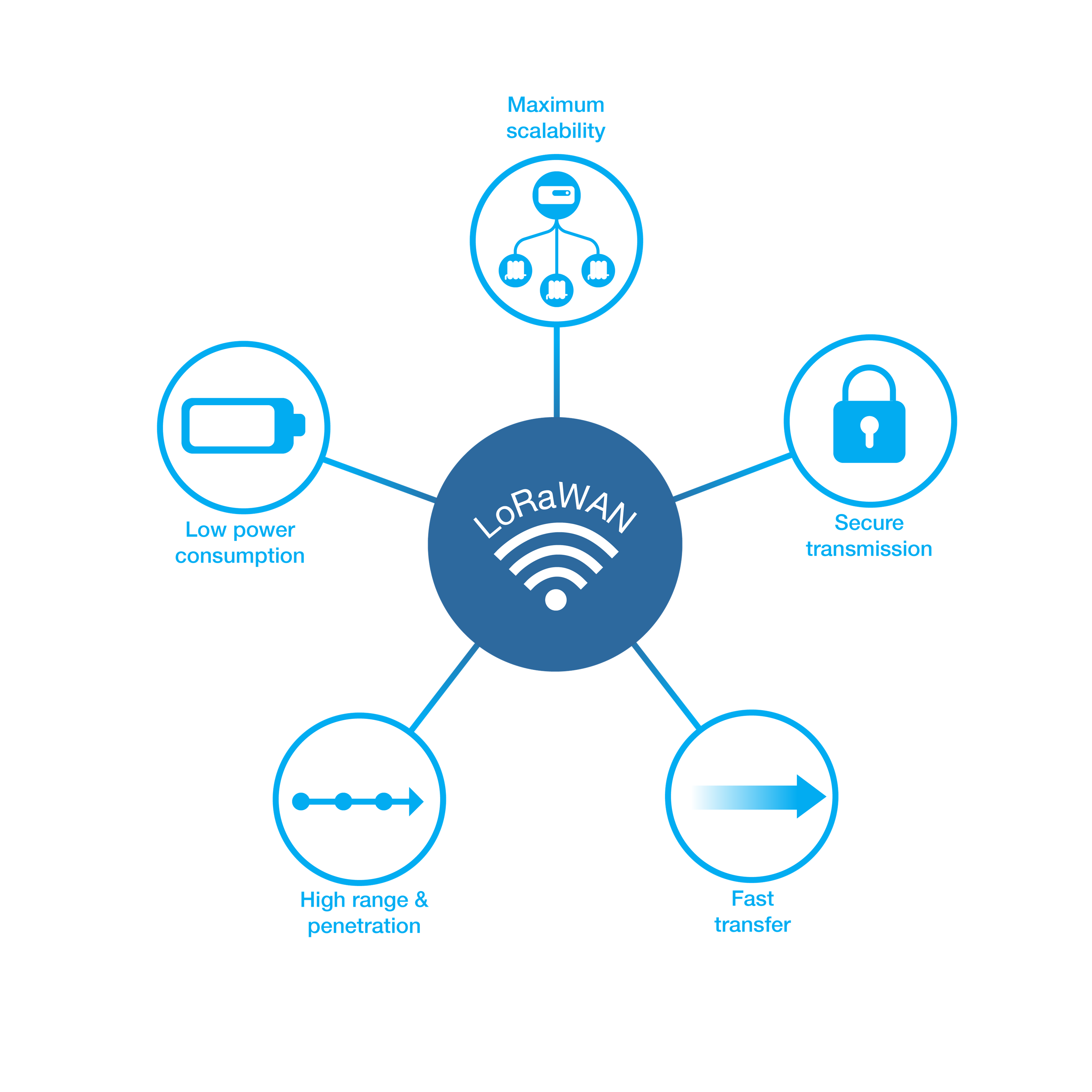The advantages of LoRaWAN: Low-radiation, fast, secure and reliable data transmission

Discover the potential of LoRaWAN for fast, reliable and low-radiation data transmission.
If you ask renowned experts in the field of the Internet of Things about the best wireless technology for IoT applications, the name LoRaWAN together with NB-IoT comes up most frequently. This is hardly surprising, after all, LoRaWAN offers enormous potential thanks to its long range, low power consumption and secure data transmission.
In this blog post, we would like to focus on the benefits of LoRaWAN for IoT applications such as smart metering.
Secure, robust and scalable – the advantages of LoRaWAN in portrait
What is LoRaWAN?
LoRaWAN stands for "Long Range Wide Area Network" and is a wireless network protocol optimized for the transmission of data over long distances. It uses license-free radio spectrum as well as low-power wide area network technology (LPWAN), making it ideal for Internet of Things (IoT) applications.
Applications based on LoRaWAN as a network protocol have numerous advantages. The main advantages of transmission technology are:
- High range and penetration capability for transmitting data over long distances
- Low power consumption and thus a long battery life for end devices in the network
- Simple and cost-effective implementation and use through the use of license-free radio frequencies
- High scalability to support a wide range of devices
- Secure and reliable transmission of data
LoRaWAN – Data transfer at high speeds
The data transmission with LoRaWAN is particularly fast as the technology transfers relatively small data packages.
By using license-free frequencies and the use of LoRaWAN gateways, the transmission of data over long distances can take place almost in real time.
Energy efficiency and radiation reduction thanks to minimal transmission power
Unlike other wireless technologies, LoRaWAN uses a low frequency range with lower transmission power. This and the avoidance of constant connection establishment and disconnection processes minimize energy consumption and reduce radiation exposure.
LoRaWAN devices have only low battery consumption and can therefore be operated autonomously and maintenance-free for a long time, which is a great advantage for many applications. The combination of low power consumption and low-radiation transmission makes LoRaWAN an environmentally friendly and sustainable solution.
LoRaWAN Network Topology
A LoRaWAN network consists of various components:
Firstly, there are the nodes, which are sensors and devices that transmit data packages from the field. These packages are then received by gateways within their range.
From there, the data is forwarded to the central component in a LoRaWAN network, the network server. The LoRaWAN network is typically structured in a star topology. The network server acts as the hub with a variety of tasks (such as message routing, data rate management, encryption and decryption, de-duplication), while the gateway establishes the connection with the nodes. This allows the gateway to also receive data from the LoRaWAN network server and pass it on to the nodes.
The network server forwards data to an application server, which processes the data and, for example, makes it available to the network operator for visualization and data analysis in an IoT platform.
Security and reliability as advantages of LoRaWAN
LoRaWAN enables secure and reliable transmission of data, which ensures the protection of privacy and protects against unlawful access. For example, the LoRaWAN protocol uses AES-128 encryption and endpoint-level authentication to ensure secure data transmission.
With LoRaWAN technology, the operator has the possibility to build his own private network and thus retains full complete sovereignty over his data.
In addition, the network protocol uses multiple channels with different frequencies to minimize interference. Interference-free transmission is ensured by monitoring the signal quality and automatic channel change.
Conclusion
In summary, LoRaWAN offers enormous potential for IoT applications such as smart metering. The advantages of this transmission technology lie in its long range, energy efficiency, scalability, security and reliability.
Overall, LoRaWAN is a promising technology, that makes IoT applications secure and efficient . In addition to LoRaWAN, we at Elvaco rely on several technologies such as M-Bus, wireless M-Bus and NB-IoT for the implementation of smart metering infrastructures.
Elvaco pursues the principle of technology openness, which does not favor any technology in principle, but rather finds the optimal solution with the most suitable technology depending on the application. For this reason, we will soon introduce you in detail to another data transmission technology from smart metering in our blog.
FAQ – frequently asked questions about the advantages of LoRaWAN
What are the advantages of LoRaWAN compared to other network protocols?
LoRaWAN enables wireless transmission of data over long distances with low power consumption and high penetration capability. LoRaWAN uses license-free radio frequencies, which facilitates implementation and use and saves costs. Compared to other network protocols, LoRaWAN is also secure, reliable and offers high scalability.
In which applications is LoRaWAN particularly suitable?
LoRaWAN is particularly suitable for Internet of Things (IoT) applications that require long battery life and reliable wireless transmission of data over long distances. A prominent example of the application of the transmission protocol is the equipment of intelligent buildings and water and heating networks. Here, LoRaWAN is used in particular for the realization of smart metering systems.


